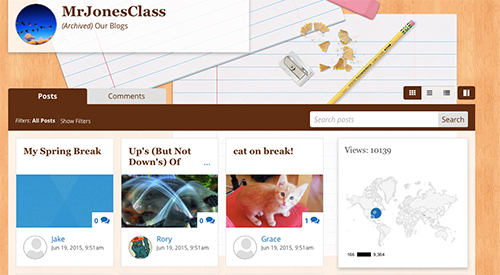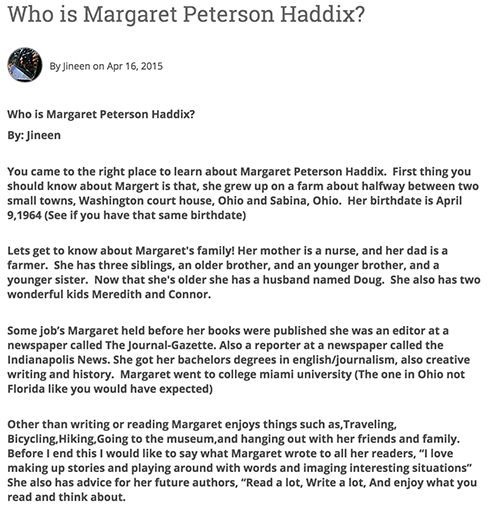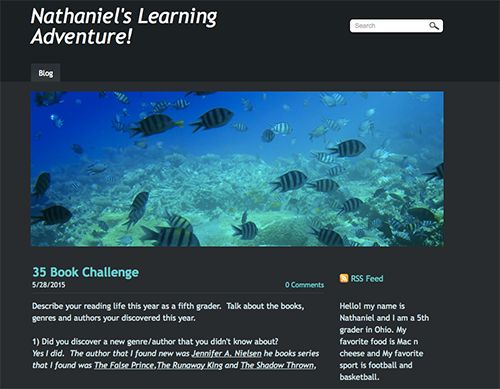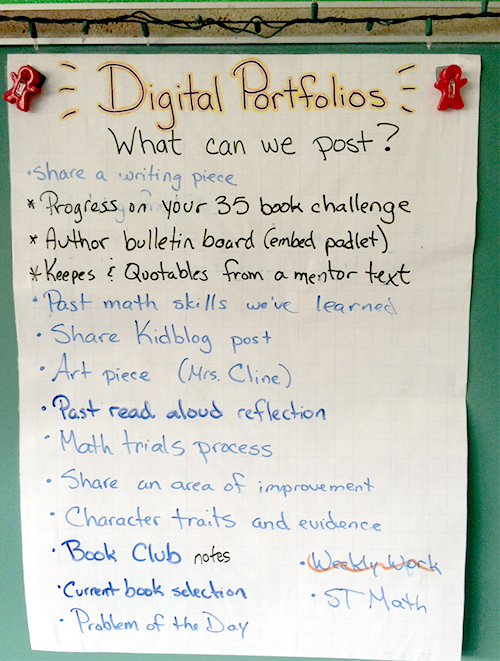Chapter 7: Cultivating Student Ownership with Audience, Autonomy, Discourse and Reflection
7.3 Essential #2: Autonomy: Allowing Student Choice

For years educational psychologists have known that an essential element of motivation is an individual’s need to feel autonomous. I will be using the word autonomy to mean students having their voices heard and the choice honored in their learning. By empowering students’ voices we show that we value them as important members of our community with important things to say and contribute. As a teacher who strives to create a personalized learning environment for my students, I recognize the importance of my students being autonomous in their reading and writing choices. I do not assign specific books or authors to students. Nor do I select a writing topic for students during writing workshop. I don’t do this because most students who lack input into decisions about their learning feel unmotivated and indifferent about improving. By giving students autonomy over what they read and write, students are more committed to developing their skills because they have choice in selecting topics and genres that are meaningful and enjoyable for them.
One of the ways my students strengthen their voice and have choice in their writing is through blogging. They use their blogs to tell their story and share pieces of writing that are meaningful to them. Students love being a blogger because it allows them to use their voice in addition to having a choice in their writing topic, genre and format. I have seen my students post a wide variety of genres and formats (e.g. personal narratives, book reviews, weekly advice columns, parodies and poetry). You can visit the page on our classroom website with resources and links about student blogging here: http://www.theflockjwr.com/student-blogging. Below, you will see two examples and very different blog post topics by Jake and Jineen.
Jake was an active and determined student who loved sports. The year had started with his parents telling me that he had not been remotely interested in reading or writing for the past few years. However, one morning in February, Jake came bounding into the classroom very excited about the Super Bowl that had occurred the previous night. After tossing his backpack onto his desk, he asked if he could spend time blogging about the game during our morning routine. While it was not Jake’s normal morning activity, it was difficult to say no to this young writer. I could see how motivated he was to write. Jake was writing about something that was personal to him. His love of sports and his excitement about the game had inspired him to compose a summary of the game. While this blog post has errors, his enthusiasm for this topic provided momentum I had not seen before. Choice in topic gave Jake incentive to write which carried through into future writing workshops.

In the next example below, you can see that Jineen has written a short biography about the author Margaret Peterson Haddix. Jineen always enjoyed writing workshop, but she struggled to produce pieces of writing of substantial length. Also, she and I had spent many writing conferences discussing strategies for adding personality or voice in her writing. Jineen had especially enjoyed a few of Haddix’s books during the year, so she wanted to learn more about the author. During reading workshop, Jineen spent 3-4 days reading as much about Haddix as she could. She searched websites and evaluated the information that she would eventually add to her biography. In an attempt to set her biography apart from other Haddix biographies, she is experimenting with adding voice and style to her writing. Jineen uses parentheses as a way to talk to the reader directly. Her first sentence signals that the reader will learn a great deal about the author. Also, in her concluding paragraph, Jineen intentionally adds quotations to leave the reader with some advice from Haddix herself. By selecting a topic that she was passionate about, Jineen was able to focus her attention on developing her a unique and natural writing voice.

Digital Portfolios – Choice and Ownership
When beginning the digital portfolio process, I knew students would need time exploring this brand new digital playground. So, I charged them with finding a template and designing their website to fit their personality. Then, I set them free to play and explore. These digital citizens are used to pointing, clicking and dragging, so I let them discover things on their own. They chose a URL (e.g. http://nathanielsjourney.weebly.com). They chose a design template, colors, fonts, and pictures for their headers. I circulated and assisted as needed; yet, I found that letting students have time to play with this new tool first allowed them to discover so many functions and elements of the website without me explicitly teaching them. Often times, students unearthed a cool feature or function and explained it to each other, all without my instruction.

Like every other learning experience, digital or not, student ownership is more likely when students fully understand the rationale behind what they are doing. Also, it is key for students to use their voice to give input on, and help shape these learning experiences. Therefore, I felt it was necessary for students to help select what types of products would be included on their digital portfolio. Knowing that this list would change many times throughout the year, we recorded our list with dry-erase marker so we could add or take away ideas. Here is the anchor chart we created:

Classroom Implications of Autonomy
As a result of having autonomy over their blog topics and digital portfolios, students were engaged in the writing process and empowered to make decisions about their writing. In addition to being completely committed to their topics, students made deliberate decisions about their writing craft with little guidance from me, which had not been the case in previous writing pieces. They were responsible for their writing and had a sense of ownership. Also, both writers improved in areas in which they had struggled because they were interested in the topic. By giving them a say in their writing topic, students did not feel inhibited to write. Essentially, they had a sense of feeling capable and successful which motivated them to improve their writing craft.